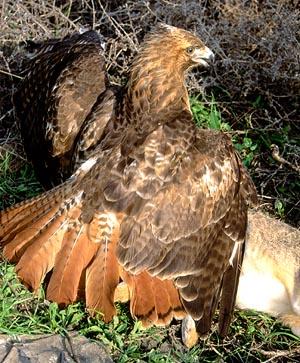The Red-tailed Hawk has a dark brown back. In adults, the chest and the underside of the wings are lighter-colored. They usually have a dark “belly band.” Its most obvious feature is a red tail that sometimes has a black stripe at the end. Individual birds vary in color; some are very light, while others are dark brown. Adults look different than young hawks.
Fun Facts:
All Red-tailed Hawks have a “chocolate bar” on the underside of each wing.
Life Cycle:
Female hawks lay 2 to 4 eggs in April or May. They hatch in about 30 days. The young remain close to the nest until they learn to fly. After they take to the air, they follow their parents on hunting trips and learn to forage (hunt) for themselves. Red-tailed Hawks typically select mates and begin breeding when they are three years old.
Ecology:
Red-tailed Hawks eat rabbits, ground squirrels, snakes, lizards, small birds and insects. Adult hawks are sometimes eaten by Golden Eagles. Many bird and mammal predators will attack the eggs and young of a Red-tailed Hawk if it leaves them unattended.
Conservation:
These hawks can be found in western Canada, all across the United States, and in Mexico and Central America. They are one of the most commonly seen hawks.
Investigate:
Practice looking up into the sky to spot hawks. Look for the red tail and the “chocolate bar” on the wing.
Some Red-tailed Hawks migrate while others do not. Why might some stay and some go? How would you study this?
